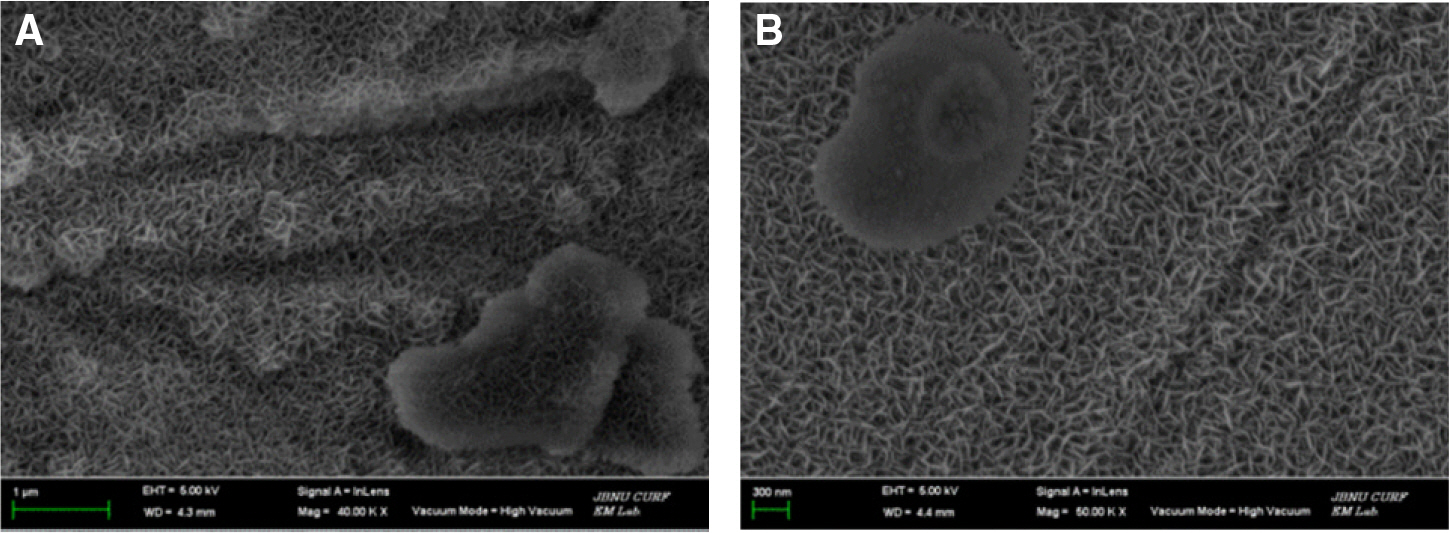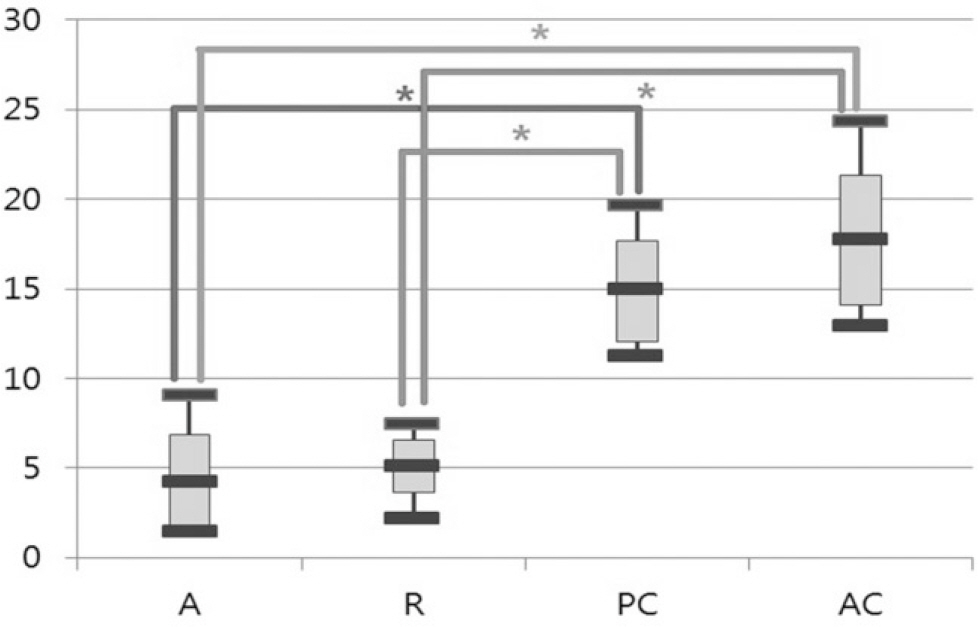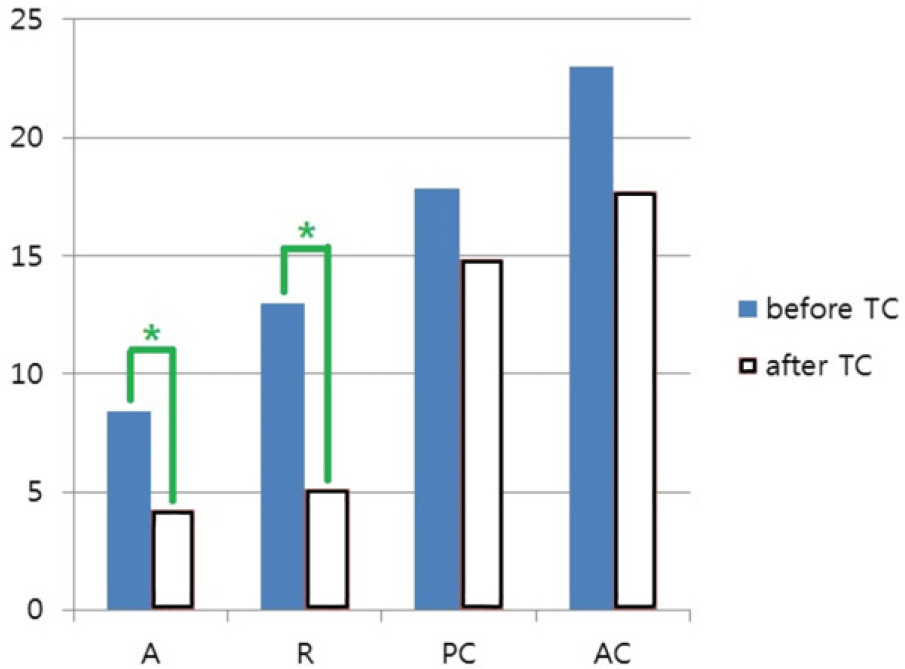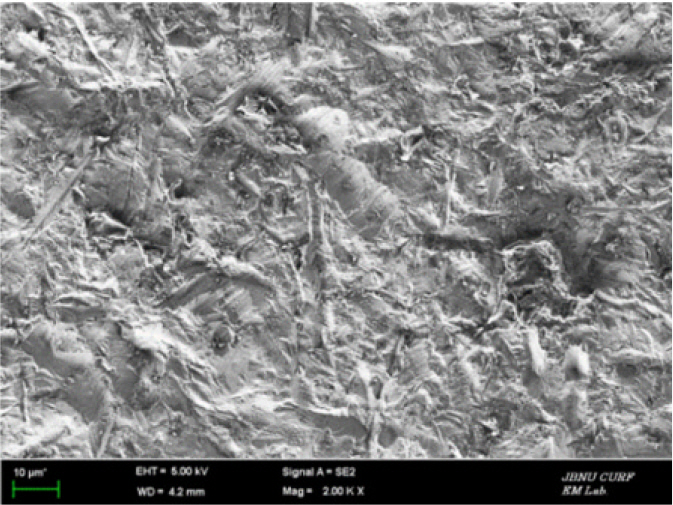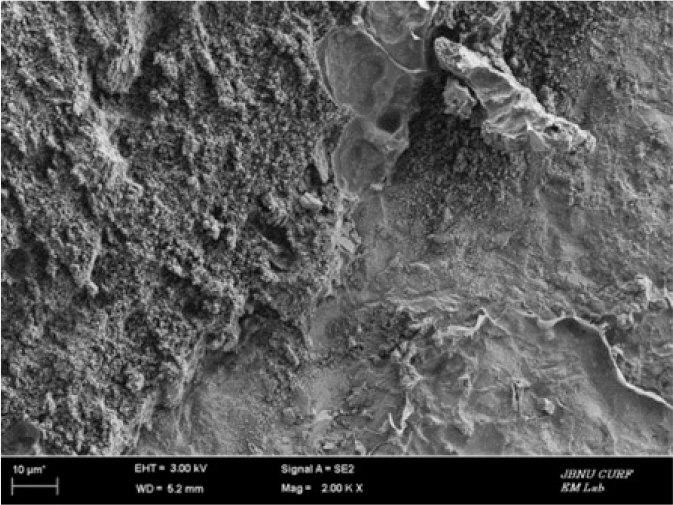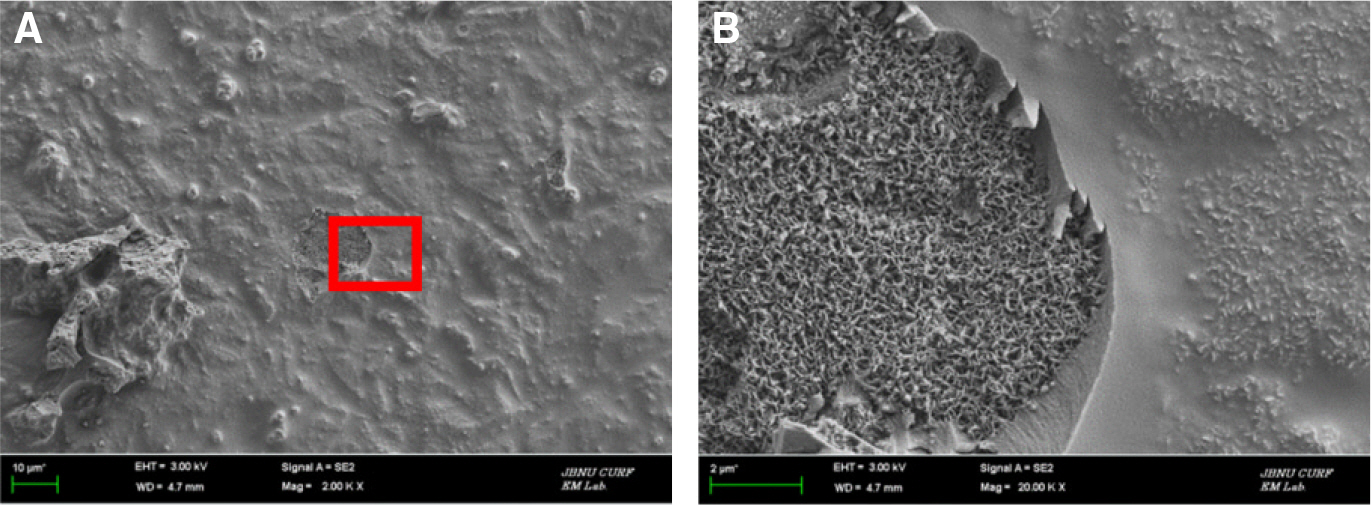J Korean Acad Prosthodont.
2016 Oct;54(4):354-363. 10.4047/jkap.2016.54.4.354.
Influence of nano-structured alumina coating treatment on shear bond strength between zirconia ceramic and resin cement
- Affiliations
-
- 1Department of Prosthodontics, School of Dentistry and Institute of Oral Bio-Science, Chonbuk National University, Jeonju, Republic of Korea. jmseo@jbnu.ac.kr
- 2Department of Dentistry, School of Medicine, Eulji University, Daejeon, Republic of Korea.
- KMID: 2388213
- DOI: http://doi.org/10.4047/jkap.2016.54.4.354
Abstract
- PURPOSE
The aim of this study was to investigate whether the application of nano-structured alumina coating to the surface of Y-TZP could enhance the bond strength with resin cement.
MATERIALS AND METHODS
A total of 80 zirconia plates were prepared and divided into four groups. : 1) airborne particle abrasion treatment (A) : 2) Rocatec treatment after airborne particle abrasion (R) : 3) nano-structured alumina coating treatment after polishing (PC) and 4) nano-structured alumina coating after airborne particle abrasion (AC). Alumina coating was formed by the hydrolysis of aluminium nitride (AlN) powder and heat treatment at 900℃. Coating patterns were observed with FE-SEM. Resin block was bonded to treated zirconia ceramics using resin cement. The shear bond strengths were measured before and after thermocycling.
RESULTS
The FE-SEM images show a dense and uniform nano-structured alumina coating structure, which enhances shear bond strength by increasing micro mechanical interlocking to resin cement. PC and AC groups showed higher shear bond strengths than A and R groups before and after thermocycling. A and R groups displayed significant drops in shear bond strength after thermocycling. However, PC and AC groups did not show any meaningful decreases in shear bond strength after thermocycling.
CONCLUSION
Treatment of Y-TZP ceramics with nano-structured alumina coating could significantly increase their shear bond strength.
MeSH Terms
Figure
Cited by 1 articles
-
Influence of nano alumina coating on the flexural bond strength between zirconia and resin cement
Canan Akay, Merve Çakırbay Tanış, Emre Mumcu, Mehmet Ali Kılıçarslan, Murat Şen
J Adv Prosthodont. 2018;10(1):43-49. doi: 10.4047/jap.2018.10.1.43.
Reference
-
1.Anusavice KJ. Recent developments in restorative dental ceramics. J Am Dent Assoc. 1993. 124:72–4. 76-8, 80-4.
Article2.Chevalier J. What future for zirconia as a biomaterial? Biomaterials. 2006. 27:535–43.
Article3.Piconi C., Maccauro G. Zirconia as a ceramic biomaterial. Biomaterials. 1999. 20:1–25.
Article4.Jevnikar P., Krnel K., Kocjan A., Funduk N., Kosmac T. The effect of nano-structured alumina coating on resin-bond strength to zirconia ceramics. Dent Mater. 2010. 26:688–96.
Article5.Denry I., Kelly JR. State of the art of zirconia for dental applications. Dent Mater. 2008. 24:299–307.
Article6.Della Bona A., Anusavice KJ., Shen C. Microtensile strength of composite bonded to hot-pressed ceramics. J Adhes Dent. 2000. 2:305–13.7.Della Bona A., Anusavice KJ. Microstructure, composition, and etching topography of dental ceramics. Int J Prosthodont. 2002. 15:159–67.8.Brentel AS., Ozcan M., Valandro LF., Alarça LG., Amaral R., Bottino MA. Microtensile bond strength of a resin cement to feldpathic ceramic after different etching and silanization regimens in dry and aged conditions. Dent Mater. 2007. 23:1323–31.
Article9.Ozcan M., Vallittu PK. Effect of surface conditioning methods on the bond strength of luting cement to ceramics. Dent Mater. 2003. 19:725–31.10.Dérand P., Dérand T. Bond strength of luting cements to zirconium oxide ceramics. Int J Prosthodont. 2000. 13:131–5.11.Aboushelib MN., Matinlinna JP., Salameh Z., Ounsi H. Innovations in bonding to zirconia-based materials: Part I. Dent Mater. 2008. 24:1268–72.
Article12.Aboushelib MN., Mirmohamadi H., Matinlinna JP., Kukk E., Ounsi HF., Salameh Z. Innovations in bonding to zirconia-based materials. Part II: Focusing on chemical interactions. Dent Mater. 2009. 25:989–93.
Article13.Blatz MB., Sadan A., Kern M. Resin-ceramic bonding: a review of the literature. J Prosthet Dent. 2003. 89:268–74.
Article14.Ozcan M., Kerkdijk S., Valandro LF. Comparison of resin cement adhesion to Y-TZP ceramic following manufacturers' instructions of the cements only. Clin Oral Investig. 2008. 12:279–82.15.Amaral R., Ozcan M., Bottino MA., Valandro LF. Microtensile bond strength of a resin cement to glass infiltrated zirconia-reinforced ceramic: the effect of surface conditioning. Dent Mater. 2006. 22:283–90.
Article16.Heikkinen TT., Lassila LV., Matinlinna JP., Vallittu PK. Effect of operating air pressure on tribochemical silica-coating. Acta Odontol Scand. 2007. 65:241–8.
Article17.Ozcan M. Evaluation of alternative intra-oral repair techniques for fractured ceramic-fused-to-metal restorations. J Oral Rehabil. 2003. 30:194–203.18.Valandro LF., Ozcan M., Bottino MC., Bottino MA., Scotti R., Bona AD. Bond strength of a resin cement to high-alumina and zirconia-reinforced ceramics: the effect of surface conditioning. J Adhes Dent. 2006. 8:175–81.19.Xible AA., de Jesus Tavarez RR., de Araujo Cdos R., Bonachela WC. Effect of silica coating and silanization on flexural and composite-resin bond strengths of zirconia posts: An in vitro study. J Prosthet Dent. 2006. 95:224–9.
Article20.Bottino MA., Valandro LF., Scotti R., Buso L. Effect of surface treatments on the resin bond to zirconium-based ceramic. Int J Prosthodont. 2005. 18:60–5.
Article21.Ural C., Külünk T., Külünk S., Kurt M., Baba S. Determination of resin bond strength to zirconia ceramic surface using different primers. Acta Odontol Scand. 2011. 69:48–53.
Article22.Mirmohammadi H., Aboushelib MN., Salameh Z., Feilzer AJ., Kleverlaan CJ. Innovations in bonding to zirconia based ceramics: Part III. Phosphate monomer resin cements. Dent Mater. 2010. 26:786–92.
Article23.Wegner SM., Gerdes W., Kern M. Effect of different artificial aging conditions on ceramic-composite bond strength. Int J Prosthodont. 2002. 15:267–72.24.Akgungor G., Sen D., Aydin M. Influence of different surface treatments on the short-term bond strength and durability between a zirconia post and a composite resin core material. J Prosthet Dent. 2008. 99:388–99.
Article25.Novak S., Kosmac T. Preparation of alumina ceramics from aqueous suspensions employing the hydrolysis of aluminum nitride. J Mater Res. 2002. 17:445–50.
Article26.Krnel K., Kocjan A., Kosmac T. A simple method for the preparation of nanostructured aluminate coatings. J Am Ceram Soc. 2009. 92:2451–4.
Article27.Zhang S., Kocjan A., Lehmann F., Kosmac T., Kern M. Influence of contamination on resin bond strength to nano-structured alumina-coated zirconia ceramic. Eur J Oral Sci. 2010. 118:396–403.
Article28.Lindgren J., Smeds J., Sjögren G. Effect of surface treatments and aging in water on bond strength to zirconia. Oper Dent. 2008. 33:675–81.
Article29.Wolfart M., Lehmann F., Wolfart S., Kern M. Durability of the resin bond strength to zirconia ceramic after using different surface conditioning methods. Dent Mater. 2007. 23:45–50.30.Kern M., Wegner SM. Bonding to zirconia ceramic: adhesion methods and their durability. Dent Mater. 1998. 14:64–71.
Article31.Phark JH1., Duarte S Jr., Blatz M., Sadan A. An in vitro evaluation of the long-term resin bond to a new densely sintered high-purity zirconium-oxide ceramic surface. J Prosthet Dent. 2009. 101:29–38.
Article32.Blatz MB., Chiche G., Holst S., Sadan A. Influence of surface treatment and simulated aging on bond strengths of luting agents to zirconia. Quintessence Int. 2007. 38:745–53.33.Amaral R1., Ozcan M., Valandro LF., Balducci I., Bottino MA. Effect of conditioning methods on the microtensile bond strength of phosphate monomer-based cement on zirconia ceramic in dry and aged conditions. J Biomed Mater Res B Appl Biomater. 2008. 85:1–9.
Article34.O¨zcan M., Nijhuis H., Valandro LF. Effect of various surface conditioning methods on the adhesion of dual-cure resin cement with MDP functional monomer to zirconia after thermal aging. Dent Mater J. 2008. 27:99–104.35.Ernst CP., Cohnen U., Stender E., Willershausen B. In vitro retentive strength of zirconium oxide ceramic crowns using different luting agents. J Prosthet Dent. 2005. 93:551–8.
Article36.Matinlinna JP., Heikkinen T., Ozcan M., Lassila LV., Vallittu PK. Evaluation of resin adhesion to zirconia ceramic using some organosilanes. Dent Mater. 2006. 22:824–31.
Article37.Lüthy H., Loeffel O., Hammerle CH. Effect of thermocycling on bond strength of luting cements to zirconia ceramic. Dent Mater. 2006. 22:195–200.38.Breschi L., Mazzoni A., Ruggeri A., Cadenaro M., Di Lenarda R., De Stefano Dorigo E. Dental adhesion review: aging and stability of the bonded interface. Dent Mater. 2008. 24:90–101.
Article39.Yang B., Barloi A., Kern M. Influence of air-abrasion on zirconia ceramic bonding using an adhesive composite resin. Dent Mater. 2010. 26:44–50.
Article40.Kosmac T., Oblak C., Jevnikar P., Funduk N., Marion L. The effect of surface grinding and sandblasting on flexural strength and reliability of Y-TZP zirconia ceramic. Dent Mater. 1999. 15:426–33.41.Kosmac T., Oblak C., Jevnikar P., Funduk N., Marion L. Strength and reliability of surface treated Y-TZP dental ceramics. J Biomed Mater Res. 2000. 53:304–13.42.Zhang Y1., Lawn BR., Malament KA., Van Thompson P., Rekow ED. Damage accumulation and fatigue life of particle-abraded ceramics. Int J Prosthodont. 2006. 19:442–8.43.Zhang Y., Lawn BR., Rekow ED., Thompson VP. Effect of sandblasting on the long-term performance of dental ceramics. J Biomed Mater Res B Appl Biomater. 2004. 71:381–6.
Article
- Full Text Links
- Actions
-
Cited
- CITED
-
- Close
- Share
- Similar articles
-
- Influence of nano-structured alumina coating on shear bond strength between Y-TZP ceramic and various dual-cured resin cements
- Effect of surface treatments of zirconia ceramic on the bond strength of resin cements
- Effect of surface treatment methods on the shear bond strength of resin cement to zirconia ceramic
- Influence of nano alumina coating on the flexural bond strength between zirconia and resin cement
- The effect of alumina and aluminium nitride coating by reactive magnetron sputtering on the resin bond strength to zirconia core


